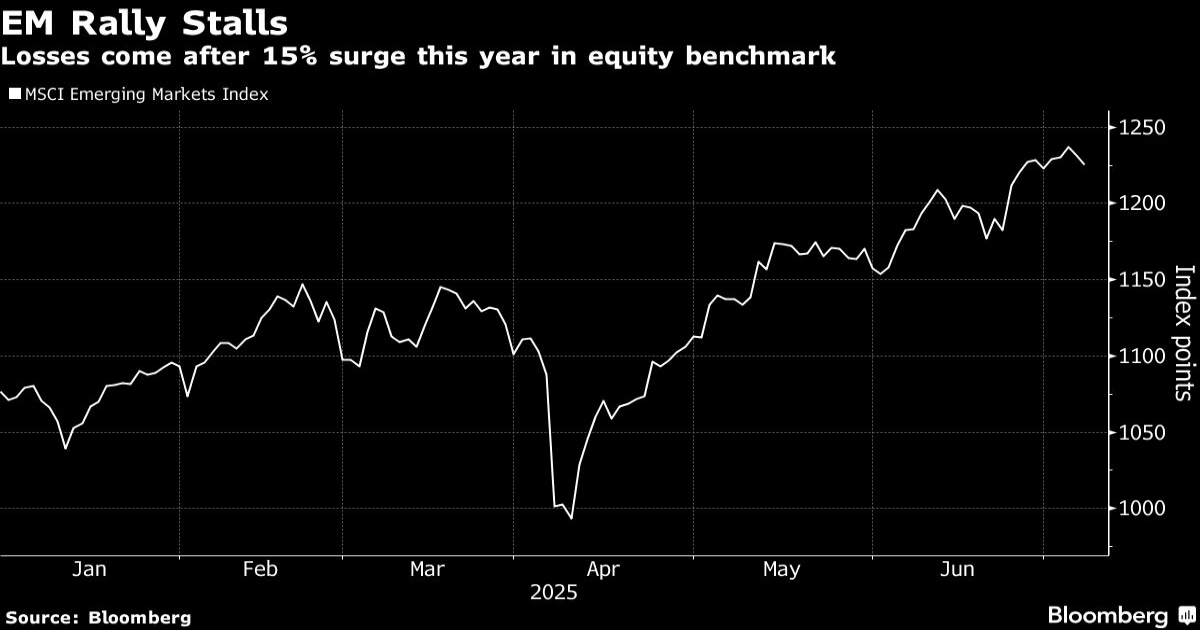(Bloomberg) — The dollar jumped the most in three weeks after President Donald Trump unveiled a wave of proposed tariffs, a sign investors are confident the US economy can largely withstand the impact of trade disputes.
Most Read from Bloomberg
The greenback strengthened 0.5% against a basket of peers on Monday, picking up steam after Trump announced levies on a handful of countries. The Bloomberg Dollar Spot Index rose the most since June 17 and currencies across the globe slumped, with Japan’s yen, South Korea’s won and Brazil’s real among those sinking more than 1%.
“The fact that some of the more problematic policies from the US administration have been dialed back — and there are deals getting done — means that the economic pain for the US won’t be as bad as originally feared,” said Skylar Montgomery Koning, a currency strategist at Barclays.
The dollar’s decline this year — down about 9% — already reflects the potential negative impact from tariffs meaning foreign currencies are likely to decline more, she added.
Trump on Monday announced levies of between 25% and 40% on countries from Japan and South Korea to Laos and Myanmar, with more expected. They are set to enter effect on August 1.
The sweeping “Liberation Day” tariffs announced in April shook investor faith in the traditional haven status of the US currency and fueled concern the aggressive levies would push the economy into recession.
But investors have begun to recalibrate recently with last week’s strong US strong payrolls data adding to support for the greenback. Pricing for Federal Reserve interest-rate cuts has eased since the jobs print, with traders betting on around 51 basis points of easing by year-end on Monday, compared with 65 basis points a week ago.
Uncertainty related to US trade policies, the economic outlook and tariff-related inflation “could push back a rate cut from where we’ve been anticipating, September, for quite some time, until December or even into next year,” Kathy Jones, chief fixed income strategist at Charles Schwab, told Bloomberg Television Monday. “It’s a really tough environment right now to make a policy call.”
What Bloomberg Strategists say:
“South Korea has often stood out as particularly vulnerable to tariffs, given its leadership in batteries, chips and cars, as well as its dependence on exports to the US. Stocks are likely to recover in coming days after an initial shock, and we’ve seen a pattern this year of local markets undoing overnight pessimism. But it’s clear the market has not priced in tariffs at a level of 25%.”
— Sebastian Boyd, Macro Strategist, Markets Live
For the full analysis, click here
In Japan, which faces a 25% tariff, the yen fell as much as 1.2% to 146.24 per US dollar, the weakest level in two weeks. In South Korea, where the levy would also be 25%, the won slipped about 1.1%.
Pioneer Investments Director of Fixed Income and Currency Strategy Paresh Upadhyaya said he was “not surprised” to see a broad-based selloff in risk assets following Trump’s announcements Monday. “If we get any negative news, which we did for South Korea and Japan, it would lead to a bout of risk aversion,” he said.
For nations elsewhere, lingering uncertainty over the final tariff rate is still hurting.
The MSCI gauge of emerging-market currencies fell 0.5%, the biggest intraday drop in three months. Trump threatened an extra 10% tariff on any country aligning itself with what he called “the Anti-American policies” of the BRICS group.
South Africa’s rand underperformed, down by about 1.5%. India’s rupee, Brazil’s real and China’s offshore yuan also declined on Monday.
The term BRICS originally referred to Brazil, Russia, India, China and South Africa, but has since expanded to include other developing nations.
Trump has said trading partners can expect a rate anywhere between 10% and 70% — implying some may have to shoulder higher tariffs than expected — though he suggested some deals are in the offing, too.
Elsewhere, speculative traders trimmed bets on the dollar decline in the week through July 1, according to Commodity Futures Trading Commission data released Monday. They now hold some $18.3 billion worth of positions tied to a weaker US currency, down some 10% from the prior week.
–With assistance from Ye Xie, Matthew Burgess, Leda Alvim, Jaehyun Eom, Prima Wirayani, Srinivasan Sivabalan, Alice Gledhill, Zijia Song, Anya Andrianova and Vinícius Andrade.
(Recasts to add market prices and CFTC data.)
Most Read from Bloomberg Businessweek
©2025 Bloomberg L.P.
